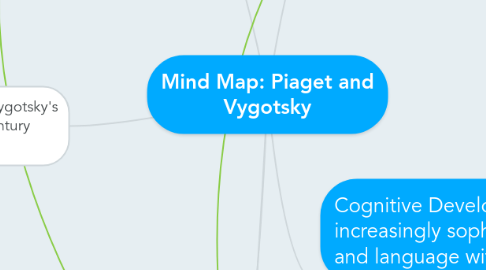
1. Differences
1.1. Influence of Cultural Environments
1.1.1. Potential influence of culture: Piaget: Recognized the potential for a child’s culture making a difference in their cognitive development but did not “systematically explore them in children’s thinking processes” (Ormrod, 44).
1.1.2. Vyogostsky: Culture is very important to the formation of children’s thinking processes (Ormrod, 44).
1.2. System of Development Stages
1.2.1. Piaget has stages of cognitive development: Sensorimotor, preoperational, concrete operations, and formal operations (Ormrod, 29).
1.2.2. No distinct development stages in Vyogostky's theories
1.3. Self exploration vs. Instruction Instruction
1.3.1. Self exploration: Piaget’s theories hold that children’s efforts make a difference in their cognitive development (Ormrod, 44).
1.3.2. Vygotsky believes the role of adults in a child’s life is of greater significance to that child’s cognitive development (Ormrod, 44).
2. Similarities
2.1. Both have a great influence on contemporary theoriesBoth theorists assert that challenges are important to a child’s cognitive development (Ormrod 44).
2.2. Age and experience increase complexity of thought processes (Ormrod, 44).
2.3. Both believe that certain tasks are experiences are within a child’s cognitive ability or readiness, while other experiences or tasks are outside of their current abilities at any particular point in their cognitive development (Ormrod, 44).
3. Vygotsky's Theories
3.1. 1. Children can accomplish more difficult tasks when assisted by more advanced and competent individuals. Vygotsy asserts that an individual’s cognitive development should be assessed “not only when performing alone but also when performing with assistance” (Ormrod, p. 38). This is called dynamic assessment.
3.2. 2. Play allows children to stretch themselves cognitively. When playing, children display behaviors that are above their age, such as role playing as a waiter. Vygotsky argues that “by adhering to such restrictions on their behavior, children learn…skills critical for suscessful participation in the adult world (Ormrod, p. 40).
3.3. Applications for Elementary Education
3.3.1. Children must be given time to "practice adult roles and behaviors through play" (Ormrod, p. 41). Younger grade level classrooms, such as kindergarten, should have materials for dress up and role-playing, such as a pretend kitchen. Older elementary-age children could be given a project in which they pretend to be a historical person, or a community helper such as a firefighter.
3.3.2. The textbook suggests that teachers give students tasks that they can only do with assistance (Ormrod, p. 41). The theory that children can accomplish more when paired with a more competent individual could be easily applied to a teacher's system of pairing students for group work. For example, a teacher could pair students who are struggling to grasp the lesson with children who have mastered it and have that student explain their thought processes to the student who is struggling.
4. Evaluation of Piaget and Vygotsky's theories based on 21st Century Learning
4.1. Modern researchers side with Vygotsky, believing that culture as a “huge influence on what children learn and how they develop” (Ormrod, 45).
4.2. Children are encouraged to talk themselves through challenging tasks, based on Vygotsky's assumptions about the benefits of self-talk (Ormrod, p. 41). Especially when performing mathematics tasks, students are often asked to explain the steps they took to solve the problem as a self-reflection method that deepens their understanding of the content at hand.
4.3. Piaget's stages can be compared to the grade-level standards such as Common Core standards for each grade level, which are used to evaluate progress in a child's cognitive development.
4.4. Piaget's theories suggest that teachers "relate abstract and hypothetical ideas to concrete objects and observable events" (Ormrod, p. 34). Is it common practice in contemporary elementary classrooms for teachers to use manipulatives to explain a math lesson. The use of a manipulative such as connector cubes, to explain an abstract concept such as volume or area, visually shows these concepts in a concrete way for students.
5. Piaget's Theories
5.1. 1. Children are active and motivated learners. Children have a natural curiosity about the world and seek out knowledge to make sense of it (Ormrod, p. 26).
5.2. 2. Children construct rather than absorb knowledge. Piaget asserted that children do not “passively soak up a collection of isolated facts,” but rather, “pull their experiences together into an integrated view of how the world operates” (Ormrod, p. 26).
5.3. Applications for Elementary Education
5.3.1. Classrooms should give children the opportunity to express their natural curiosity by providing materials and manipulatives that spark interest and a desire to learn
5.3.2. Based on Piaget's theory that children do not passively absorb isolated facts, it would be beneficial to always connect new learning to children's prior knowledge. For example, if children learn about the tallest man in the world and then have a math lesson later on subtraction, the children could subtract their height from the height of the tallest man in the world to build off of previous knowledge.
